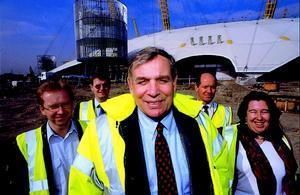At midnight on the 31 December 1999, the 300 acre Greenwich peninsula will be the focal point of the UK's Millennium celebrations. This is in marked contrast to the windswept dereliction which characterised the site for the last 20 years. It's heavily polluted soil (known officially as complex ground conditions) required extensive decontamination. But in April 1997 the way was clear for the driving of 8000 piles.
Then there was the small matter of the Blackwall Tunnel which cuts across the site. A most inconveniently sited ventilation shaft presented an immovable object which the architects and structural engineers were forced to incorporate within the Dome's 100 000 m² tensile fabric roof.
Necessity being the mother of invention, the designers have screened this interruption with panache. Indeed, portholes are now being cut in the steel and fabric curtain to give visitors a peek at the not-unattractive ventilation tower, designed by architect Terry Farrell during his days at the GLC.
The team
The lead architect for the Millennium experience is Richard Rogers Partnership, with Buro Happold as the lead engineering consultant. The client is the New Millennium Experience Company, led by chief executive Jennie Page and chairman Bob Ayling, the chief executive of British Airways. The main contractor is a joint venture between Robert McAlpine and Laing Construction.
The company was formed on the initiative of the Millennium Central Ltd, a government-owned company with non-departmental public body status.
Following the General Election of May 1997, the new Government reviewed the project, and on 19 June 1997 the Cabinet gave its approval for the Millennium Experience – the 12 themed exhibitions.
Construction
The first of the twelve 100 m high steel masts arrived on-site in August 1997. Temporary cable anchors held the masts in place while the cable net was assembled. Radial stringer cables were laid out at ground level, connected to form a web, then lifted at the connection nodes to the mast tops. The double-skin ptfe-coated glass fibre roof was then attached in sections.
There is over 75 km of high strength steel cable in the structure, the largest being 90 mm in diameter. The tension load in the centre has been calculated at 1600 tonnes, with 1000 tonnes of load down each of the 12 masts.
The cost
The Millennium Experience will cost a whopping £758 million. No money from tax revenues will be used, although the National Lottery is contributing £399 million – more than the cost of the site and structures.
The rest is being met through a combination of sponsorship, income from ticket sales, and merchandising. The first five founding sponsors, who have each committed a minimum of £12 million in sponsorship value, are BT, Manpower, Marks & Spencer, Sky and Tesco.
Other sponsorship commitments, including support from BA, BAA, Camelot, the Corporation of London and others, has brought the total to £100 million, or two-thirds of the sponsorship target of £150 million. The NMEC has discounted any top-up from the public purse, but the shortfall is still a financial hot potato which could become a political banana skin.
Commercial sponsorship commitments, plus revenue from ticket sales, is scheduled to bring in £194 million, which presumably will be taxed.
The future
At the topping out ceremony on 22 June 1998, the Prime Minister declared the Dome to be a national legacy, thus ending speculation about the building's long-term future at Greenwich. The controversial themed Millennial Exhibition – currently in a feverish design phase – is another matter. As it is only scheduled to last 12 months, it means the Dome will be redundant after January 2001. A decision has yet to be made on the building's long-term future, but for the record it is big enough to contain two Wembley stadiums, 13 Albert Halls, all of Trafalgar Square (including Nelson's column) and, rather more surreal, the Eiffel Tower lying on its side.
Source
Building Sustainable Design






















